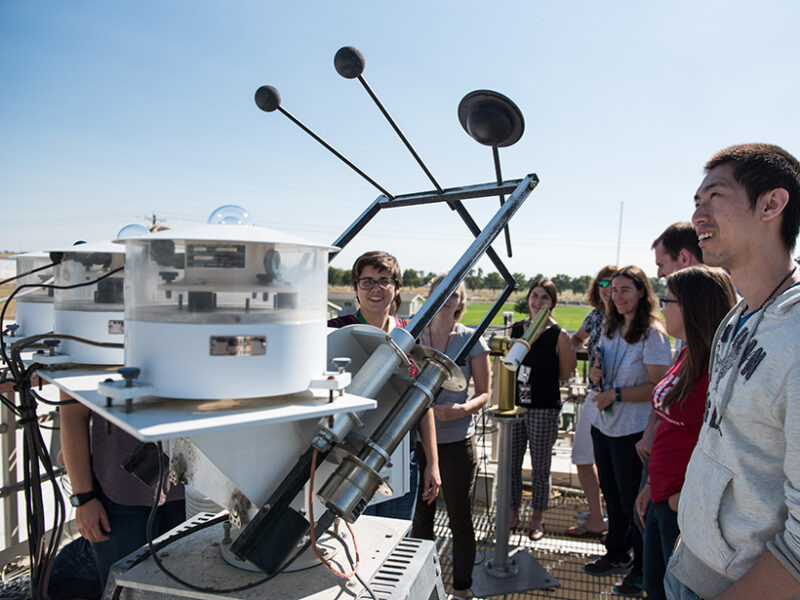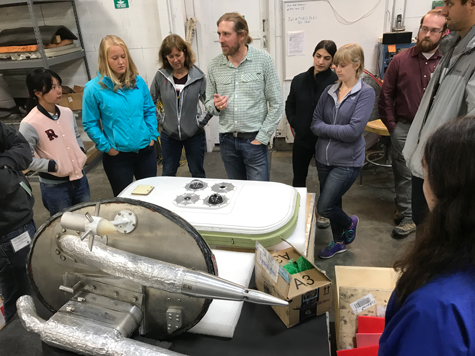
Scientific discovery in the atmospheric sciences depends on data from field campaigns, surface observations, satellites, and other observational data sets. Many of these data sets and the tools used to collect them are stewarded by national laboratories and government agencies because of the scale of the infrastructure needed to support them. Although some graduate students in the atmospheric sciences have an opportunity to participate in data collection activities, many students graduate without appreciating where the data that they rely on for their research come from.
In an effort to bridge that gap, 10 University of Washington (UW) graduate students traveled to the Pacific Northwest National Laboratory (PNNL) in Richland, Wash., in September 2017 to participate in a 2-week intensive short course on instrumentation taught by PNNL scientists and engineers. The goal of the course was to enhance the future research careers of these students by exposing them to state-of-the-art atmospheric instrumentation and data collection techniques and thus help ensure that the next generation of scientists will understand the factors affecting strengths and limitations of observational data used in complex atmospheric studies.
The course was designed to develop data literacy in atmospheric researchers who will be using advanced data sets but are not necessarily planning careers in instrument development or operation.Surveys of university programs in atmospheric sciences show that the number of departments offering courses in instrumentation declined between 1964 and 2000, with fewer than 20% of departments offering graduate-level courses in instrumentation [Cohn et al., 2006]. There is a growing gap between the complexity of modern measurement technology and the ability of universities to provide adequate training to understand measurements. Several approaches to bridge this gap have been successful, such as partnerships between universities and national laboratories (e.g., Storm Peak Laboratory [Hallett et al., 1993; Borys and Wetzel, 1997]), designing courses in which students participate in research flights [Hallet et al., 1990; Fabry et al., 1995], and student-led field campaigns [Rauber et al., 2007].
The approach we used was to offer an advanced graduate course for credit at the University of Washington and embed the course at a national laboratory instructed by instrument experts. The course was designed to develop data literacy in atmospheric researchers who will be using advanced data sets but are not necessarily planning careers in instrument development or operation. The rigor of a for-credit graduate course facilitated a depth of engagement beyond simple demonstrations or descriptions of instruments.
Defining a CurriculumThe course was jointly designed by UW professors and PNNL researchers to produce a curriculum that reflected good pedagogical techniques, in-depth contact with the process of collecting observational data, and hands-on experience.
 Jason Tomlinson, director of engineering for the PNNL’s ARM Aerial Facility, demonstrates aircraft sensors to the UW class. Credit: Robert A. Houze Jr.
Jason Tomlinson, director of engineering for the PNNL’s ARM Aerial Facility, demonstrates aircraft sensors to the UW class. Credit: Robert A. Houze Jr.
Twenty PNNL scientists and engineers worked together to teach the course, which included engagement with a range of instruments and measurement techniques used in atmospheric science, such as passive (radiometric) and active (radar and lidar) remote sensing, aircraft in situ measurements, and laboratory measurements in atmospheric chemistry and cloud formation (Table 1). To tie together these diverse topics and reinforce key factors relevant to any measurement effort, each instructor covered a common set of themes: calibration, accuracy and uncertainty, instrument sensitivity, the physics of how atmospheric parameters are sampled, performance in the field, and practical considerations related to siting or operations. The course also covered data logging and data management techniques, which are critical skills for making data sets useful for research.
As a result, the students gained an understanding and appreciation of the full data life cycle, from designing experiments to installing and calibrating instruments, collecting quality observational data, interpreting the data, and archiving data for future use. As described by radar engineer Joseph Hardin, “we tried to present the students with information that went beyond textbooks and addressed the realities of working with these instruments in a research capacity.”
Encouraging Student EngagementThe students took ownership of their learning, using the multiple scientists and engineers at the institution as resource experts. A professor with teaching experience handled assessment and student coordination, but the course content was taught by instrumentation experts. We used three strategies to create this type of engagement.
First, the course created an environment of immersive learning. Instructors gave at least 3–4 hours of consecutive instruction in the morning on each topic and then spent the second half of the day leading interactive activities such as experiments, demonstrations, data analysis, and tours. By capping the course enrollment at 10, interaction between students and instructors was extensive.
Students chose to work with data from a wide range of instruments, including broadband and spectral radiometers, multifrequency radars, Raman lidars, and experiments measuring aerosols.Second, student presenters were responsible for summarizing the content of the previous day each morning. This method of assessment allowed further engagement on topics that weren’t clear and required students to take ownership of the information.
Finally, after 2 weeks of instruction, each student designed an individual project with a PNNL mentor. The students were required to pick a project in an area different from their current research to help them engage with new material. We gave the students several weeks to complete analysis of observational data from areas they’d learned about in the class and prepare a short report summarizing their findings.
Students chose to work with data from a wide range of instruments, including broadband and spectral radiometers, multifrequency radars, Raman lidars, and experiments measuring aerosols. Project topics included the utility of water vapor retrievals from Raman lidar for studying the remote marine boundary layer, calculating aerosol yield of isoprene from chamber experiments, and radar retrievals of median volume drop size diameter using observations from the Midlatitude Continental Convective Clouds Experiment.
Training Future LeadersFrom the outset, students received the course with enthusiasm: It took only hours for 10 students to register for every available seat in the class. The students also had wide-ranging areas of study, from those who worked primarily with observational data to those who worked mainly with computer models.
“I was really interested in getting a chance to learn some of the nuts and bolts of these observations and instruments I was using all the time,” said Sam Pennypacker, a third-year graduate student who analyzes data out of the Azores from the Atmospheric Radiation Measurement Program (ARM) User Facility. “Learning it from the experts, the instrument mentors, you can’t beat that. You can only get so much from reading documentation.”
The students are eager to apply what they learned. Second-year graduate student Qiaoyun Peng will get that opportunity when she participates in a National Science Foundation–sponsored field campaign in 2018: The Western Wildfire Experiment for Cloud Chemistry, Aerosol Absorption and Nitrogen (WE-CAN) will use airborne instrumentation to study atmospheric chemical reactions within western U.S. wildfire plumes.
“I feel much more confident to conduct a field experiment after the course,” Peng said. “It’s also a great opportunity for me to feel what it is like to work in a national lab and get in touch with top scientists in my field to design a small project together.”
Jessica Haskins, a fourth-year graduate student who uses aircraft instrument data in her research, called the class an “unprecedented opportunity.”
“This course was by far the one I’ve learned the most from in graduate school,” Haskins said.
The students expressed that the class filled a missing element in their career preparation and that they would be more effective researchers armed with this newly gained appreciation for state-of-the-art measurement technology and challenges. The success of this effort has encouraged us to pursue this type of course with other graduate students in the coming years.
Table 1. Course Schedule Showing Topics and Instructorsa
Monday Tuesday Wednesday Thursday Friday Week 1 Morning Introduction to PNNL and ARM: Ian Kraucunas and Jennifer Comstock Broadband radiometers:Laura Riihimaki Spectral radiometers:
Connor Flynn
Radar: Nitin Bharadwaj, Joseph Hardin, Brad Isom, and Andrei Lindenmaier Radar: Nitin Bharadwaj, Joseph Hardin, Brad Isom, and Andrei Lindenmaier Afternoon Data logging: Victor Morris Data management: Chitra Sivaraman, Krista Gaustad, Sherman Beus, and Ken Burk Spectral radiometers:
Connor Flynn
Radar: Nitin Bharadwaj, Joseph Hardin, Brad Isom, and Andrei Lindenmaier Radar: Nitin Bharadwaj, Joseph Hardin, Brad Isom, and Andrei Lindenmaier Week 2 Morning Lidar: Rob Newsom Aircraft: Jason Tomlinson Aircraft: Jason Tomlinson Aircraft: Jason Tomlinson Ice/liquid cloud nucleation: Gourihar Kulkarni Afternoon Lidar: Rob Newsom Aircraft: Jason Tomlinson Aircraft: Jason Tomlinson Atmospheric chemistry: John Shilling, Alla Zelenyuk-Imre, David Bell, and Kaitlyn Suski Wrap-up
aThe course was taught from 9:00 a.m. to 5:00 p.m. local time each day with a break for lunch.
The post Training a New Generation of Data-Savvy Atmospheric Researchers appeared first on Eos.
from Eos https://eos.org/project-updates/training-a-new-generation-of-data-savvy-atmospheric-researchers?utm_source=rss&utm_medium=rss&utm_content=training-a-new-generation-of-data-savvy-atmospheric-researchers
via IFTTT

